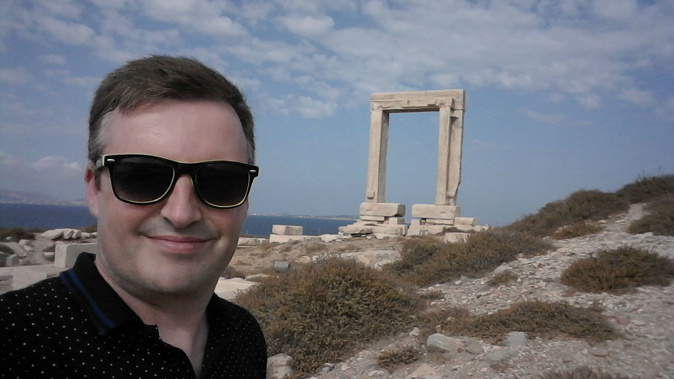
Don’t you love stumbling upon a destination which totally smashes your expectations? It’s one of the greatest thrills about travel. And the Greek island of Naxos is that sort of place. As I sailed in to the verdant, fertile and Cycladic treasure-chest of Naxos, the sense of discovery and delight swept me up. A towering marble doorway, crowning a rocky outcrop next to the harbour, rose up to greet me. Few islands possess such a stunning archaeological landmark to jolt freshly arriving ferry passengers from their lumbering slumber across the sea.
Disgorging from my Blue Star ferry in the heart of Naxos Town, I was transfixed by that gigantic ancient doorframe. The locals call it the Portara, (which means portal) built in 522BC as the doorway to the ancient Temple of Apollo. They say if you stand in the doorway and make a wish, you’ll feel the cosmic energy of Apollo start weaving his magic to make it come true. I’m still waiting. Adorning a rocky islet in the harbour and connected by a causeway, the temple itself was never finished.
Commissioned by the local ruling tyrant, Lygdamis, he had grand designs on constructing the most glorious temple in Greece, which would have probably ended up being one of the ancient wonders of the world. But he was overthrown part-way through its construction, which never was completed on the grandiose scale he’d envisaged. Later converted into a Christian church, it was later disassembled by the Venetians, who plundered the marble blocks for their hill-top castle, the kastro, lording over Naxos Town. Mercifully, the doorway was simply too heavy to pulldown – so they left as it is, an enduring landmark of inspiration and wonder.
As was the case with nearby Syros, which I wrote about recently, the Venetians permanently stamped their mark on Naxos, over their three hundred year rule. The Venetians loved these Cycladic islands, using them to form a natural bridge in the sea to underpin their trading power. Naxos Town is a photogenic princess, with a meandering waterfront edged by quintessential whitewashed buildings, while the Venetian seat of the power, dominates the upper reaches in the hilly old quarter called the Kastro.
Within the castle walls, stroll by the swarm of medieval Venetian residences which have been continuously inhabited since their construction, the Catholic Cathedral and a variety of noble old structures which have been thoughtfully repurposed. The Glezos Tower, which has been fully restored, is a typical Venetian tower and an appetiser to the multitude of feudal towers that still serrate the island’s countryside. Pop into the Archaeological Museum, which boasts some fine examples of white marble figurines and ceramics, unearthed in Naxos and showcasing 6000 years of local civilisation. Oh, how I felt like a fleeting flicker in time, as I gazed at goblets from the Neolithic Age.
If you like getting lost in a tangle of super-skinny winding lanes, explore the neighbouring Bourgos district, where the Greeks lived when Venetians called the shots. Brimming with Lilliputian-sized shops and equally enticing restaurants, there’s two dining stand-outs. Vassilis is the island’s oldest family tavern, handed down from father to son over multiple generations, serving traditional cuisine. Across the lane, Lucullus is the oldest operating restaurant in Naxos, established in 1908. Its walls are crammed with traditional cooking implements, but its signature dishes venture beyond the usual tourist fare. Plump for the rabbit stew, or the snail-and-onion stew, spicy cheese salad or delicious veal in lemon sauce.
To complete your bearings, Grotta is the town’s northern district, while Agios Georgios Beach graces the southern part of town, with golden sands, gentle waves and a slew of beachside bars and cafes. Families love it. Liberally sprinkled all around the waterfront, vast swathes of multi-coloured wooden tables and chairs beckon passers-by, in classic Grecian fashion. I’m sure there must be calendars dedicated to the multi-coloured design palette of al-fresco café seating in the Greek Islands. It’s pure artistry, on the footpath.
Where to stay? Perched above the ocean, in the cliff-hugging Grotta district of Naxos Town, with unobstructed views of the Potara, Hotel Grotta is a perfectly-formed family-run boutique property bursting with Greek warmth. Sunset-seekers? You’re in seventh heaven. Freshly renovated with 22 spacious rooms, all with balcony or a terrace, you’ll enjoy recharging in the pool, hot tub, sauna and steam room. Nicoleta and Dimitri are charismatic hosts who will happily pick you up from the ferry, if you don’t want tackle the short hill walk – which isn’t actually that onerous. Enjoy a welcoming glass of wine on arrival and a tasty teropita. (Cheese pie) The breakfast buffet is mouth-wateringly delicious and bountiful, with hot and cold dishes and home-made treats to please every palette. Hotel Grotta is a runaway class act and incredulously inexpensive. www.hotelgrotta.gr
Naxos Town, also called Chora, is a sweetly seductive and effortless hub – frankly, you could have a thoroughly contented and languid island break without straying beyond the town’s limits. But you’d be selling yourself short. The island’s remarkable interior and far-flung coastal jewels are simply irresistible. Venture into the countryside where the rolling green hills and valleys boast a slew of antiquities, clusters of Byzantine churches, medieval towers, and marble villages where time stands still.
It’s a 6 hour journey from Piraeus across the millpond-smooth waters of the Aegean, with a few ports of call en-route to and from Naxos. I sailed with the super-efficient and friendly team on Blue Star Ferries. They operate a wealth of routes and offer a great range of on-board services. It’s the only way to sail the Greek seas. www.bluestarferries.gr
Mike Yardley is Newstalk ZB’s Travel Correspondent on Saturday Mormings with Jack Tame.
Take your Radio, Podcasts and Music with you









